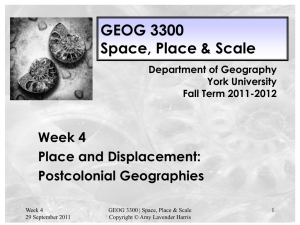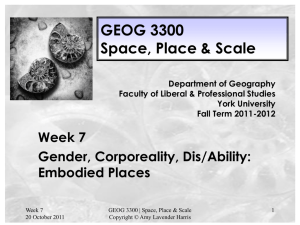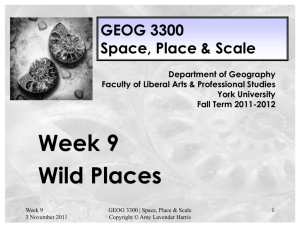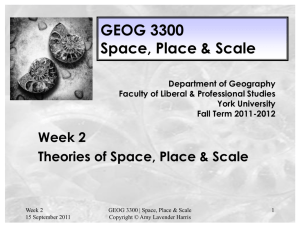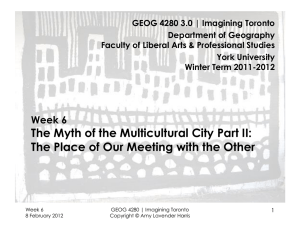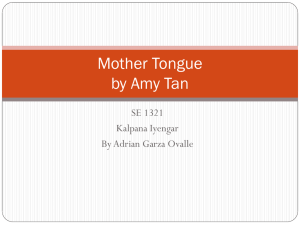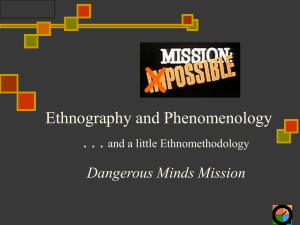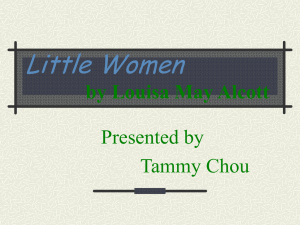GEOG 3300 Week 3 Phenomenologies of Place lecture slides 2011
advertisement
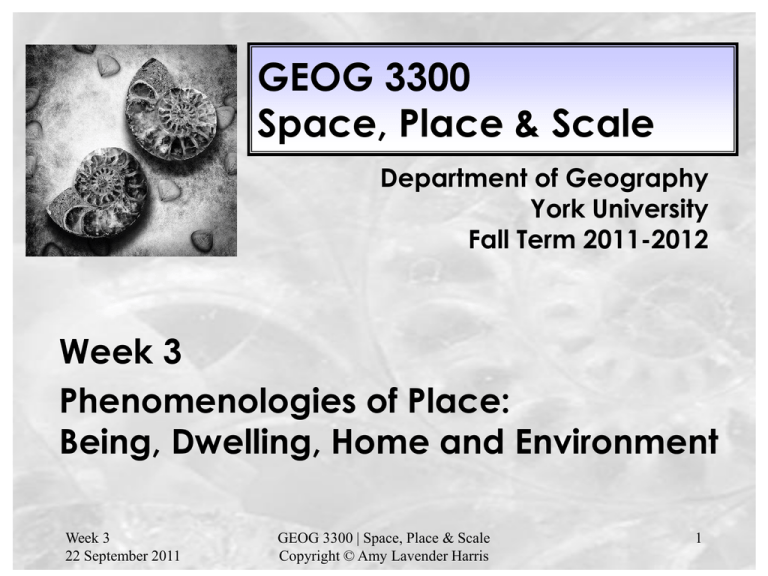
GEOG 3300 Space, Place & Scale Department of Geography York University Fall Term 2011-2012 Week 3 Phenomenologies of Place: Being, Dwelling, Home and Environment Week 3 22 September 2011 GEOG 3300 | Space, Place & Scale Copyright © Amy Lavender Harris 1 First Reading Response Assignment • Reminder that the first reading response assignment will be due in class next week (29 September 2011) • Handout distributed in class last week; also available on the course website. • Choose any reading from Weeks 1-4 and engage critically with it. One effective way to do so is to apply its concepts to some new experience or example. • Don’t just summarize the reading: “do” something with it! • Don’t forget to introduce your argument with a thesis statement. Week 3 22 September 2011 GEOG 3300 | Space, Place & Scale Copyright © Amy Lavender Harris 2 Critical Essay (Term Paper) • Critical term essay of 10-12 pages, due on 6 December 2011. Note that an outline and annotated bibliography are due on 10 November 2011. • Opportunity to write about any theme or issue that interests you, as long as it develops an understanding of some aspect of space/place/scale. • Must be informed by a theoretical approach / contextual literature. • Must be analytical rather than merely descriptive (take an opinion, and/or apply the theoretical concepts to a new experience or setting). • Recommendation: choose a specific subject, theme, place, or experience Week 3 22 September 2011 GEOG 3300 | Space, Place & Scale Copyright © Amy Lavender Harris 3 Outline and Annotated Bibliography • Due 10 November 2011; worth 10% of your final grade. • 1-2 page outline introducing your topic and the main cases examples or arguments you will use to explore it. • Your paper may (and probably will) change after you submit the outline: the purpose of submitting an outline is to receive feedback well before submitting the final paper. • Annotated bibliography: at least five scholarly sources – write 50100 words about each source, offering a brief overview of the work and indicating its anticipated relevance to your work. Week 3 22 September 2011 GEOG 3300 | Space, Place & Scale Copyright © Amy Lavender Harris 4 GEOG 3300 Term Paper: Suggestions for Organization Section Content Pages 1 Introduction: thesis statement (explain what you are writing about, how you will do so, and why it is important or meaningful), summary of arguments you will use 1 or 2 2 Context / background: brief explanation of theoretical perspective(s) that inform your paper. Where does this perspective ‘fit’ in the literature/debates on SPS? 2 to 3 3 Analysis: A thoughtful, complete exploration of your subject (using evidence and examples) that justifies / fulfills your thesis statement. 5 to 7 4 Conclusion. 1 at most Don’t forget to choose an interesting title and provide full references and notes as necessary. Yes, you can use “I”. Week 3 22 September 2011 GEOG 3300 | Space, Place & Scale Copyright © Amy Lavender Harris 5 Approach Descriptive Phenomenological Social Constructionist Week 3 22 September 2011 Associated Schools Preoccupations with Place -Regional Geography (Richard Hartshorne) -Early cultural geographers (Carl Sauer) -Spatial Science (1970s) -‘ideographic’ -‘chorology’ -Regions and cultures -Place as a thing: ontologically given -Environmental determinism (although Sauer held that culture transforms nature) -‘Place’ remains largely undefined Phenomenology (Heidegger, MerleauPonty, Bachelard) -Humanistic geographers (Yi-Fu Tuan, Anne Buttimer, David Seamon, Ted Relph, Edward Casey) -experienced, ‘embodied’ or lived place --’topophilia’ (Tuan) -Home and dwelling -belonging and attachment -‘authenticity’ Place as primordial or Place as “mutually constituted” by environment and culture -‘romantic’? Naïve? -‘Radical’ Geography -Marxism (David Harvey -Feminism (Gillian Rose, Doreen Massey) -Poststructuralism and postcolonialism (Edward Soja, Homi Bhabha, Edward Said) -Social determinism: places as socially constructed -Spatial ‘turn’ in the cultural and social sciences -Class, gender and race -Transgression and resistance; power and privilege -Postcolonial legacies -‘ungrounded? Incoherent? -What happens to ontology? GEOG 3300 | Space, Place & Scale Copyright © Amy Lavender Harris 6 At the Threshold of Place “’A threshold,’ wrote the third-century philosopher Porphyrus, ‘is a sacred thing.’ Thresholds, though wider than the idea of doors, share their role as repositories of desire and temptation. What is opened at a door? Onto what landscape of the imagination does a threshold gaze? Gaston Bachelard has written that a door is an entire cosmos of the half-open. A threshold is perhaps, by extension, a cosmos of the already half-understood.” [Gary Michael Dault, Cells of Ourselves, 1989] “A boundary is not that at which something stops but, as the Greeks recognised, the boundary is that from which something begins its essential unfolding.” [Martin Heidegger, “Building Dwelling Thinking” in Basic Writings, 1977; 1993] Week 3 22 September 2011 GEOG 3300 | Space, Place & Scale Copyright © Amy Lavender Harris 7 What is Phenomenology? • The study of ‘structures of experience;’ of ‘things as they appear.’ • Subjective consciousness – consciousness (being/Being) that is always oriented (or is always ‘intentional’) toward some object, entity, experience or meaning. • Phenomenology emerged in the late nineteenth century but is largely a 20th century movement. • Noted phenomenologists in the philosophical tradition: Edmund Husserl, Martin Heidegger, Maurice Merleau-Ponty, Emmanuel Levinas. • Noted spatial theorists who have engaged with phenomenology: Gaston Bachelard (The Poetics of Space), Edward Casey (today’s reading), Ingrid Leman Stefanovic, Ted Relph (Place and Placelessness), Yi-Fu Tuan (who sees himself primarily as a Humanist), Robert Mugerauer, David Seamon Week 3 22 September 2011 GEOG 3300 | Space, Place & Scale Copyright © Amy Lavender Harris 8 Home as a Phenomenological Object: Understanding Phenomenology • Phenomenology: the study of phenomena (anything that appears or presents itself to experience; appearances and essences) • Experience: the senses (sight, sound, touch, belief, memory, imagination, excitement, anger, loss, judgment, movement • Consciousness is intentional (that is, always directed toward phenomena) • History of phenomenology as a response to Enlightenment empiricism and the fixation on mathematically derived ‘laws of nature’ • ‘Reality’ must include not only measurable, quantifiable objects but also subjective properties of the ‘lifeworld’; normative (evaluative) questions also deserve answers. • Phenomenologists reject Cartesian dualities between ‘inner experience’ (subjective) and the ‘outer world’ (objective) Week 3 2 September 2011 GEOG 3300 | Space, Place & Scale Copyright © Amy Lavender Harris 9 Home as a Phenomenological Object: The Phenomenological Approach • • • • • • Philosopher Edmund Husserl (the first phenomenologist): science is also ontological (concerned with various ways of experiencing reality) and epistemological (concerned with various ways of knowing) Husserl: we begin by suspending [bracketing] our assumptions about what is ‘real’ or ‘natural’ Through a process of phenomenological reduction [epoche] we bring to light the “essential intentional contact between consciousness and the world” (Peet, 1998: 38) The epoche reveals the I (the cogito, the self, consciousness), the world (the phenomenon) and the conjunction between the two. For Husserl, this is how we come to understand the lifeworld. (the moving, historical field of lived experience) The ‘real’ is not simply ‘given’. There is no meaningful a priori ‘reality’ separate from consciousness. Week 3 22 September 2011 GEOG 3300 | Space, Place & Scale Copyright © Amy Lavender Harris 10 More on the Phenomenological Approach • • • • • • German philosopher Martin Heidegger’s phenomenology focuses on the ultimate existential question: what is the meaning of being? Heidegger focuses on uncovering the forgotten fundamental structures of being For Heidegger, Being = Dasein = “being there” Dasein is always “thrown” into a concrete situation: the everyday world; the core phenomenological project is making sense of this everyday world (H. rejects the idea that space is merely a container) Other phenomenologists: Maurice Merleau-Ponty (perception and embodiment), Gaston Bachelard (the poetics of space), Alfred Schultz (phenomenological sociology) Phenomenological geographers: Edward Casey, Ted Relph, Robert Mugerauer, Ingrid Leman Stefanovic, [Tuan?], David Seamon, Joseph Grange, Michael Zimmerman, Anne Buttimer, Tim Cresswell Week 3 22 September 2011 GEOG 3300 | Space, Place & Scale Copyright © Amy Lavender Harris 11 ‘Doing’ Phenomenology • “… the phenomenologist does not seek to derive categorical evidence of universal truth claims. As with all phenomenological projects, this reading cannot be a conclusive, systematized product, but rather, a step along the way in our investigations of places. Hermeneutic deconstructions of interviews with residents; phenomenological interpretations of literary or artistic moments in the history of each settlement; phenomenological descriptions of key landmarks or essential pathways; further interior reflection …” (Stefanovic, 1998: 32) Week 3 22 September 2011 GEOG 3300 | Space, Place & Scale Copyright © Amy Lavender Harris 12 The House • • • • • • “Before he is “cast into the world” … man is laid in the cradle of the house. … Life begins well, it begins enclosed, protected, all warm in the bosom of the house.” (Gaston Bachelard, The Poetics of Space, [1964] 1994: 7) “…our house is our corner of the world … it is our first universe, a real cosmos in every sense of the word.” (ibid.: 4; also quoted in Stefanovic, 1998: 41) Architect Witold Rybczynski muses in Home: A Short History of an Idea (1986) that ‘home’ conveys ideas about nostalgia, intimacy and privacy, domesticity, commodity and delight, ease, light and air, efficiency, style and substance, and comfort and well-being as well as chosen austerity. Perhaps a romanticized history of the idea of home? Other meanings? The home as keep? Its thresholds as separations? Boundaries, barriers? Prisons, even? Not all encounters with home are happy (e.g., domestic violence, war, displacement) What if one has no place to call home? (e.g., Tuan on migrant workers’ children; displaced peoples) Week 3 22 September 2011 GEOG 3300 | Space, Place & Scale Copyright © Amy Lavender Harris 13 The Body • • • • • • • • • • • In Topophilia (1974) Geographer Yi-Fu Tuan (a humanistic geographer) suggests that people measure objects in space against the scale of our own bodies. In Space and Place (1977) Tuan claims that infants have no “world” and cannot distinguish between self and the external environment. Tuan’s developmental approach is borrowed from famous developmental psychologist Jean Piaget, who argued that learning is inherently spatial. Spatial experience begins with simple coordinates: ahead, behind, sideways, up, down, horizontal, vertical. Spatial language: home, away, here, there, street names, etc. Spatial fantasies Learning about space by exploring it Technological impacts on spatial learning (e.g., aerial photography, fast-moving vehicles). Geopolitics also affects spatial learning in individuals (e.g., warm, travel, migration); so too does gender (in many places boys enjoy greater mobility) The point here is that experience matters when we encounter place. This is at the heart of the phenomenological approach to space/place. Week 3 22 September 2011 GEOG 3300 | Space, Place & Scale Copyright © Amy Lavender Harris 14 What makes a place ‘home’? • Operative words: “place” and “home”. • The idea that there is something about the experience of a particular place that makes it home: – Intimacy, privacy, security, separation between ‘inside’ and ‘outside’, the present of a threshold. – The idea of retreat or return. – The idea of origin. – There is something corporeal about home. Room womb. Week 3 22 September 2011 GEOG 3300 | Space, Place & Scale Copyright © Amy Lavender Harris 15 What does it mean to be ‘homeless’? • Opposite of ‘home’? Intersection with dwelling? A continuum? • Note that we are forced beyond the literal, ideographic, material almost immediately. • Can you live in a house and still be homeless? [soulless condos, empty suburban houses, etc. • Are all unhoused people ‘homeless?’ (e.g., Shauneesy BishopStall’s Toronto book, Down to This (2004); Maggie Helwig’s Toronto novel, Girls Fall Down (2008). • At risk of becoming homeless: “The City of Toronto defines homelessness as a condition of people who live outside, stay in emergency shelters, spend most of their income on rent, or live in overcrowded, substandard conditions and are therefore at serious risk of becoming homeless.” (City of Toronto, 2003. Toronto Report Card on Housing and Homelessness. ) Week 3 22 September 2011 GEOG 3300 | Space, Place & Scale Copyright © Amy Lavender Harris 16 Spatial Dualities • Dualities: inside/outside, inclusion/exclusion, past/future, prison/sanctuary, building/destruction, joining/rupture, arrival/departure, peace/war, home/homelessness • The most prominent duality? Self [as a subject] / Other [as an object]; also mind/body • Dualities as a main legacy of the Enlightenment approach to science [knowledge] in which the world was catalogued and categorized into discrete parts. • Dualities are tremendously useful in science, but they can also conceal the reality that nature does not divide itself so easily into rigid categories. • Philosopher Bruno Latour argues that we stern culture “purifies” ontological categories by eliminating objects (e.g., the homeless) that call their separation into question. Week 3 22 September 2011 GEOG 3300 | Space, Place & Scale Copyright © Amy Lavender Harris 17 Transcending Dualism • Moving beyond “either/or” categories: culture/nature, Self/Other, subject/object [the biggest dualities] • The phenomenological subject • Subjectivity and intersubjectivity • The meaning of Being: moving beyond Descartes “cogito ergo sum.” Week 3 22 September 2011 GEOG 3300 | Space, Place & Scale Copyright © Amy Lavender Harris 18 What does it mean to Dwell? • • • • • • • • A central concern of phenomenology in geography. Heidegger: “the plight of dwelling lies in this, that mortals ever search anew for the essence of dwelling, that they must ever learn to dwell.” (Building Dwelling Thinking) Dwelling and building: “the build is in itself already to dwell” Building (bauen) means “to dwell”: to remain, to stay in a place, to cherish and protect, to care for, to preserve, to cultivate (gardens and edifices), to spare, to set free We dwell in the fourfold (earth, sky, gods, mortals) Building as gathering (gathering the fourfold into a locale): consider a bridge “To preserve the fourfold, to save the earth, to receive the sky, to await the divinities, to initiate mortals – this fourfold preserving is the simple essence of dwelling. In this way, then, do genuine buildings give form to dwelling in its essence, and house this essential unfolding.” Genuine building is to bring [rather than challenge] forth, to let appear, to unfold. Techne / technology. Week 3 22 September 2011 GEOG 3300 | Space, Place & Scale Copyright © Amy Lavender Harris 19 Raymond Koukal on Dwelling • • • • • • • • Thinking philosophically, we still begin with the everyday environment of home Elevating dwelling to questions of meaning: To reside; to be accustomed to; to be familiar with; to cherish where one is; to care; to “build through cultivation and construction”; to be at peace; preserving or sparing from harm or danger; to dwell is to be mortal (?) According to philosopher Raymond Koukal, “I dwell” because “I have an environment to which I belong … within this space I am involved in a doing … I am also involved with others.” Dwelling as building, as engaging, as using our space and the tools in it Dwelling as familiarity Dwelling as connected to Being (or, to the concept of self and identity: we are where and how we dwell?) Koukal: Buildings themselves have little to do with dwelling, but building does.” (64). What does this mean? Koukal: “buildings built as homes carry no guarantee that dwelling will occur in them” Week 3 22 September 2011 GEOG 3300 | Space, Place & Scale Copyright © Amy Lavender Harris 20 Raymond Koukal on Homelessness • • • • Koukal’s definition of homelessness:“Those which do not dwell belong neither to Others, nor the “they.” They do not belong because they have no location within our environment. Since they do not belong in this manner they do not exist in familiarity. Their sole involvement is with their own “mere” existence in a place to which they do not belong, and so they can hardly be said to be cultivating pf constructing anything. In this sense, they cannot be said to be “doing” anything, to be “building” anything, and so they do not dwell. Yet they exist.” (Koukal, 67) When familiarity, cultivation, building, or sparing are ruptured, we become homeless. Our indifference – or, our paternal condescension – to others (or ‘Others’) makes us all homeless. How? (encountering others as if they were equipment or distant objects) A problem is that we cannot help fibrillating between modes of care (“leaping in” vs. “leaping ahead”) Week 3 22 September 2011 GEOG 3300 | Space, Place & Scale Copyright © Amy Lavender Harris 21 Koukal continued … • Because of the recognition that it is our own failure to fully dwell or care or preserve; that is, we fail to recognize the homeless as fellow beings [as fellow mortals] • It is important that the homeless stand out to us so that we may recognize our responsibility to liberate them from their discrete environments. • We cannot truly dwell until we truly have care that others dwell, too. • Their homelessness is also our homelessness • “It remains to be seen whether or not the discrete dissonance of the homeless among us will bring us into an authentically poetic reckoning, or to a time so destitute that even the efforts of the poets will be rendered futile.” Week 3 22 September 2011 GEOG 3300 | Space, Place & Scale Copyright © Amy Lavender Harris 22 Phenomenological Encounters with Place: (I) Cavtat and Mississauga • • • Ingrid Stefanovic’s phenomenological encounters with Cavtat (a town in Croatia near Dubrovnik)) and Mississauga’s Square One Sense of place in Cavtat: (1) interplay of insideness/outsideness; (2) anchorage in a clear centre; (3) reflective of time and human finitude; (4) the grace of the earth; (5) the interplay of mystery and disclosure; (6) dwelling within spontaneity and possibility … But … effects of the war in the former Yugoslavia (ethnic hatred, bombings) Sense of place at Square One: (1) anchorage in a commercial centre; (2) point-oriented relation of inside to outside community; (3) the rural ideal preserved (or caricatured … City Hall silo); (4) privacy and enclosure; (5) reflective of time as the present; (6) freedom as autonomy … But …requires an idealized, romantic view of place/home/dwelling and concealment of the unsustainability of suburban places … flight(?) • Week 3 22 September 2011 GEOG 3300 | Space, Place & Scale Copyright © Amy Lavender Harris 23 Stefanovic continued … • Note focus on specific settings; “description”. • But “description” means something unusual here. • Note also emphasis on process, becoming, “learning” to dwell (and to understand dwelling). • Personal journey: being-at-home. • Note that Stefanovic suggests that “place” cannot be defined using conventional language; perhaps we require phenomenology to understand place. (see page 32) Week 3 22 September 2011 GEOG 3300 | Space, Place & Scale Copyright © Amy Lavender Harris 24 Phenomenological Encounters with Place (II): Vari Hall • • • Meaningful encounters with Vari Hall: looking beyond the material Movement, encounters, temporality, sensory elements, emotions, reflection, narration Vari as: - a place of meeting - A transitive place - Proximity, distance, immersive, interpretive, sensing, responsive - Emotional connection; memory, fear, longing - Power? Control? Belonging? - What of the new benches? Laptop outlets? Music, dance, meeting, protest? - [How] can a person ‘dwell’ in Vari Hall? Week 3 22 September 2011 GEOG 3300 | Space, Place & Scale Copyright © Amy Lavender Harris 25
